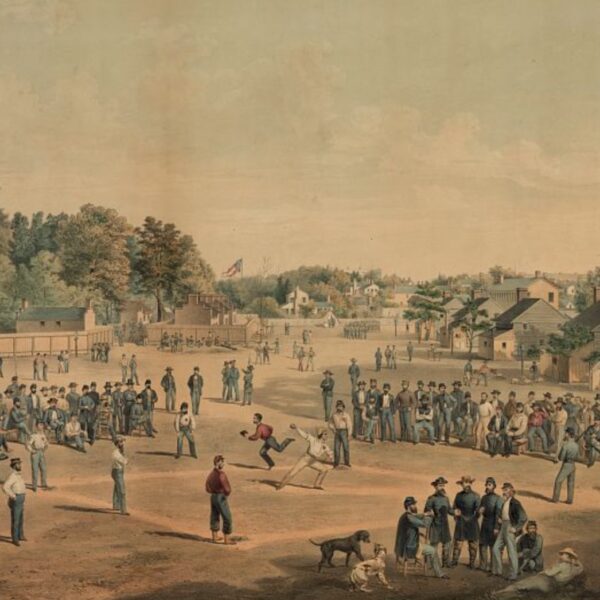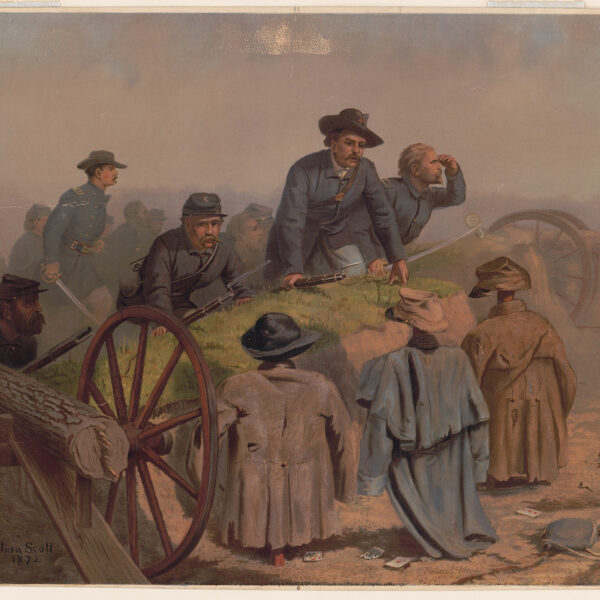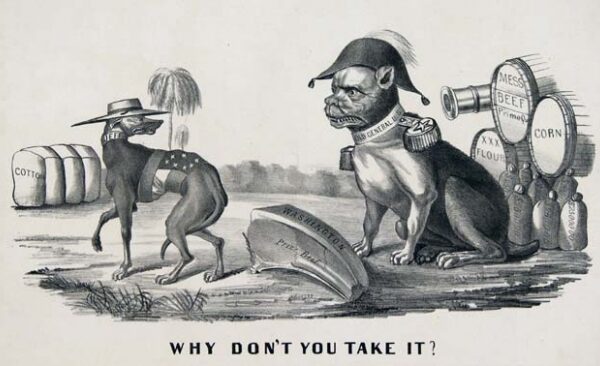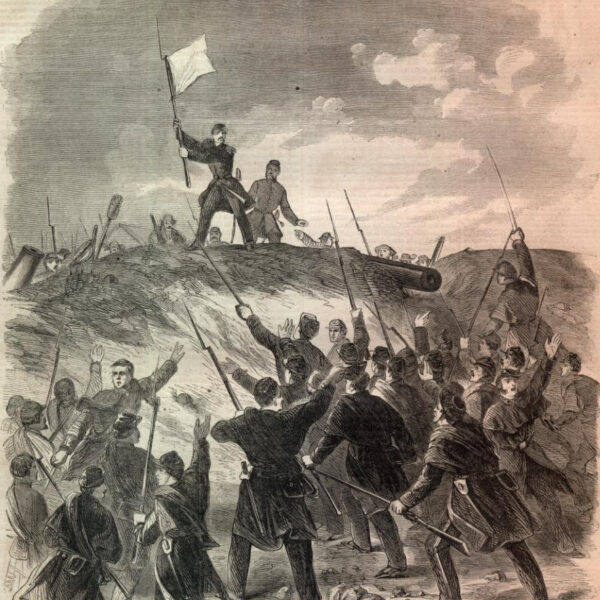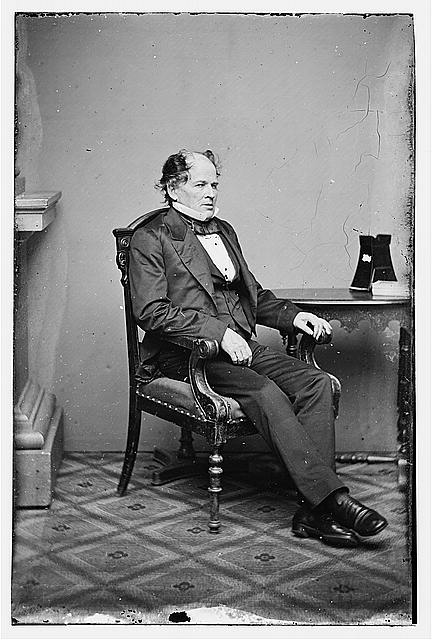
In October 1862 during a wide-ranging meeting, the French Emperor Napoleon III asked Commissioner John Slidell why the Confederacy didn’t have a navy capable of breaking the blockade. The two discussed French advances in armoring ships, and Napoleon III dropped broad hints to look to private French yards. This was the flicker of light Commander James D. Bulloch, Confederate naval agent in Great Britain, saw as Lord Palmerston’s government was under increasing pressure from Washington to crack down on Confederate ship-buying on the island and in Ireland.
Slidell told Bulloch and Commissioner James Murray Mason in London that the emperor was very encouraging when their discussion turned to arms and ships. There were two private French shipyards close to Great Britain–where Bulloch and Commander Matthew Fontaine Maury, the famed scientist and member of the Confederate Secret Service, were–and Paris, where Confederate Navy Captain Samuel Barron headquartered in the Grand Hotel. The two shipyards were Arman’s in Bordeaux and Vorduz in Nantes, both with reputations for quality and capable technology. Like Emile Erlanger, the banker who put together the sale of cotton bonds on European exchanges, the owners were “solid with the emperor” and members of his parliament.1
Bulloch needed the French yards more than ever. The British had seized Alexandra, a suspected commerce raider, in a Liverpool yard, and pressure in Parliament on Laird Brothers in Birkenhead mounted over the rams they were building. Laird earlier had delivered its “290” to the a front for the Confederates who then named it Alabama, and Charles Francis Adams, the United States minister to Great Britain, delivered document after document to Whitehall showing how British neutrality was being violated. Foreign Minister John Russell told Palmerston privately it was time for a public investigation of the ships’ ownership. Both understood that way their government’s hands would be “clean” in a demonstration of neutrality. Bulloch knew that any investigation meant the rams, designed as commerce raiders with enough punch to attack Northern ports, would be lost.
For Slidell, Bulloch, and Maury dealing with the French, the rush was on. To speed the work at Arman’s shipyard, Bulloch agreed in April 1863 to an elaborate fee system that retained but a hair’s breadth of difference from bribery. There were to be four ships, built ostensibly for private trading companies working in China and San Francisco, and they were to be armed “to ward off pirates.”2
Maury’s work with the French was patriotic and personal. As he told the mayor of Halifax in a stopover on his way to Great Britain, his mission was to command an oceangoing warship; and if he did, Maury would best elderly Franklin Buchanan, a “Plucking Board” member who forced his retirement in the 1850s, and first commander of CSS Virginia, and the aged Josiah Tattnall, its last commander, as a sea-going warrior. This was his best chance to do that.
In late April and early May, drawings on the new class–called the “Cupola rams”–were exchanged among Bulloch, Maury, and Marin Jansen, a Dutch naval officer and longtime friend of Maury’s. The three wanted ships, drawing about fifteen feet, that could smash through the Union Monitors, something the Birkenhead rams couldn’t do. To make the vessels doubly deadly, Maury attached a spar torpedo on the bow, like the classic Athenian trimenes and CSS Virginia.
When Union diplomats got word from bribed shipyard employees, they were stunned. Arman’s ironclads “would have posed the gravest peril to which the American Union has ever been exposed.” They would be the naval complement to Lee’s Army of Northern Virginia. The diplomats rolled up their sleeves to sabotage the Confederate scheme.3
After Mallory gave the go-ahead to buy in France, Maury crossed the channel in early June 1863 to meet Arman. The Confederates envisioned a ship with “two screws–1,280 tons displacement–220 h.p.–eight guns–for 60,000 pounds.” The two screws allowed the ship to turn in a river or harbor and direct fire at targets on water and ashore. Delivery was expected in seven months. An optimistic Slidell wrote Mason, “I have no doubt that he can build on as good terms as in England, but will have no difficulties in carrying his ship to sea.”4
Because the money was to come from the Erlanger loan, Maury needed the Confederate commissioners’ permission to proceed. After listening to his plea, Mason and Slidell, joined by former Mississippi congressman L.Q.C. Lamar, now commissioner to Russia, put one condition on granting the money: The emperor openly acknowledge the ships were for the Confederacy. That acknowledgment left full diplomatic recognition a baby’s step away. What the three diplomats did not grasp was how much the political situation in France pivoted yet again. Great Britain’s reluctance to recognize the Confederacy after the Emancipation Proclamation caused France’s position to change once more. The emperor would not go it alone in the American war.5
In the Tuilieries on June 18, 1863 with the victory at Chancellorsville known, the nephew of the original Napoleon listened to Slidell who at last got around to the meeting’s real purpose: Declaring the vessels on the ways in Bordeaux be built openly for the Confederacy. To Slidell’s amazement, Napoleon III insisted construction could go ahead ONLY if “their destination be concealed.”6
While this did not bar the door to construction, it put a guard by it. The commissioners’ conditions crippled what was the Confederacy’s last best chance to take the naval war to Union ports. For Maury, try as he might, could not get enough funds, even from sales of existing cotton certificates, to proceed.
By early 1864, the French Ministry of Marine declared Arman’s ironclads could not go to any belligerent in the American war. A furious Bulloch wrote, “There never was any pretense of concealing them from the emperor’s government, because, they were undertaken at its instigation.”7
Arman and the Confederacy had gone too far together to let the ironclad program expire. Bulloch patched together an installment payment plan, and the yard was back at work on newly named Cheops and Sphinx supposedly for the British viceroy of Egypt, a scam too similar to the one used for the rams. The ploy failed.
Union authorities in France prematurely breathed a sigh of relief after they heard the news that one ironclad was going to Prussia and the other to Denmark, two European nations at war with each other.8
A frustrated Bulloch explained if money be regularly appropriated, he could build twenty such ships. However, “our finances will not admit of my contract for more than two at this time.” That one sentence summed up Confederate arms buying and shipbuilding abroad. There was never enough money to prolong the war until the North became too weary to fight.9
Yet the saga of the French ships for the Confederacy was not over.
In the spring of 1865, Bulloch, Maury, and Barron labored to get Stonewall, one of Arman’s powerful warships, into Confederate hands and under way from Denmark. They succeeded, but it was too late. The United States minister to France was amazed that the Confederate Navy continued to put guns on ships and get them to sea even when their cause was lost.10
John Grady, a former managing editor of Navy Times and retired communications director of the Association of the United States Army, is completing a biography on Matthew Fontaine Maury. He has contributed to the New York Times “Disunion” series, the Civil War Monitor, and is a blogger for the Navy’s Sesquicentennial of the Civil War site.
1. Warren E. Spencer, The Confederate Navy in Europe (University of Alabama Press: Tuscaloosa, 1997) 146-151; James D. Bulloch, The Confederate Secret Service in Europe, Vol. 2 (available as Google E-Book) 24; “The State Department: Mr. Benjamin to Mr. Slidell,” New York Times, Jan. 19, 1863.
2. Spencer, Navy in Europe, 150-151, 153-155.
3. Matthew Fontaine Maury Diary, entries, June 4, and 25, Nov. 3, all 1863, Vol. 57, Maury Papers, Library of Congress; John Bigelow, Retrospections of an Active Life, Vol. 2 (available as Google e-Book) 150-151, 284; Louis Martin Sears, “A Confederate Diplomat at the Court of Napoleon III,” American Historical Review, Vol. 26, No. 2, January 1921, 255-281.
4. MFM diary entries, June 4 and 25, Nov. 3, all 1863, Vol. 57, MP, LC.
5. Spencer, Navy in Europe, 145, 157-160.
6. Ibid.
7. Bulloch, The Secret Service of the Confederate States in Europe, Vol. 2, 58.
8. James D. Bulloch to Secretary of Navy Mallory, July 20, 1863, pp. 468-469 and Oct. 20, 1863, Official Records of the War of Rebellion Navy, Vol. 2, Ser. 2, pp. 507-511. MFM to Secretary of Navy Mallory, July 6, 1863, MP, Vol. 18, LC; Bigelow, Retrospections, Vol. 2, 150-151, 284; J. Thomas Scharf, History of the Confederate Navy, From its Organization to the Surrender of Its Last Vessel (Random House: New York, 1996) 804-805.
9. Bulloch to Mallory, July 20, ORN.
10. ORN, Ser. 2, Vol. 2, 1069; Bigelow, Retrospections, Vol. 2, pp. 406-407, 431-432.

